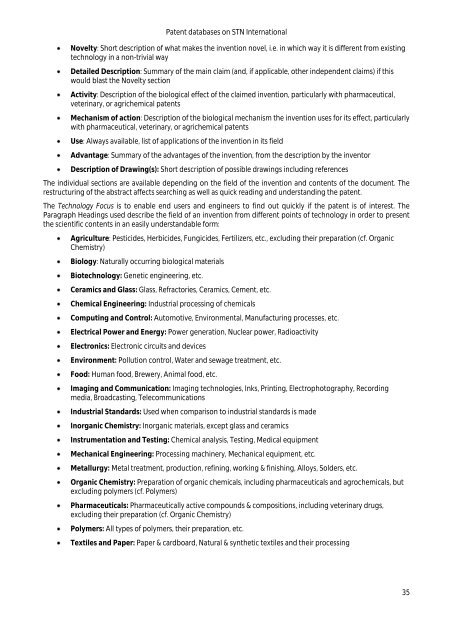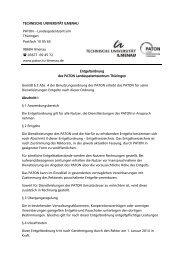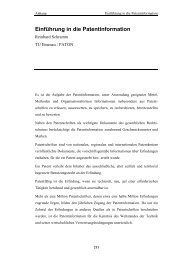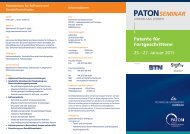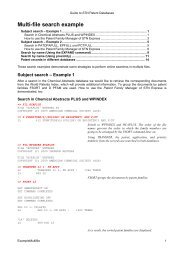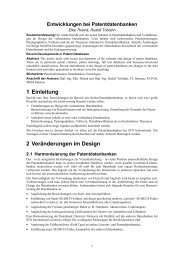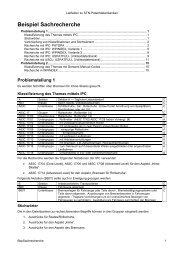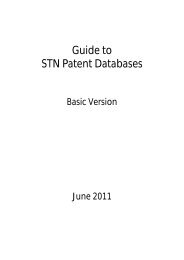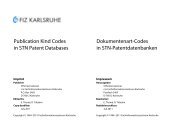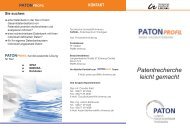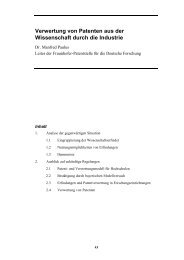Guide to STN Patent Databases – Basic Version - Paton - TU Ilmenau
Guide to STN Patent Databases – Basic Version - Paton - TU Ilmenau
Guide to STN Patent Databases – Basic Version - Paton - TU Ilmenau
Create successful ePaper yourself
Turn your PDF publications into a flip-book with our unique Google optimized e-Paper software.
<strong>Patent</strong> databases on <strong>STN</strong> International<br />
Novelty: Short description of what makes the invention novel, i.e. in which way it is different from existing<br />
technology in a non-trivial way<br />
Detailed Description: Summary of the main claim (and, if applicable, other independent claims) if this<br />
would blast the Novelty section<br />
Activity: Description of the biological effect of the claimed invention, particularly with pharmaceutical,<br />
veterinary, or agrichemical patents<br />
Mechanism of action: Description of the biological mechanism the invention uses for its effect, particularly<br />
with pharmaceutical, veterinary, or agrichemical patents<br />
Use: Always available, list of applications of the invention in its field<br />
Advantage: Summary of the advantages of the invention, from the description by the inven<strong>to</strong>r<br />
Description of Drawing(s): Short description of possible drawings including references<br />
The individual sections are available depending on the field of the invention and contents of the document. The<br />
restructuring of the abstract affects searching as well as quick reading and understanding the patent.<br />
The Technology Focus is <strong>to</strong> enable end users and engineers <strong>to</strong> find out quickly if the patent is of interest. The<br />
Paragraph Headings used describe the field of an invention from different points of technology in order <strong>to</strong> present<br />
the scientific contents in an easily understandable form:<br />
Agriculture: Pesticides, Herbicides, Fungicides, Fertilizers, etc., excluding their preparation (cf. Organic<br />
Chemistry)<br />
Biology: Naturally occurring biological materials<br />
Biotechnology: Genetic engineering, etc.<br />
Ceramics and Glass: Glass, Refrac<strong>to</strong>ries, Ceramics, Cement, etc.<br />
Chemical Engineering: Industrial processing of chemicals<br />
Computing and Control: Au<strong>to</strong>motive, Environmental, Manufacturing processes, etc.<br />
Electrical Power and Energy: Power generation, Nuclear power, Radioactivity<br />
Electronics: Electronic circuits and devices<br />
Environment: Pollution control, Water and sewage treatment, etc.<br />
Food: Human food, Brewery, Animal food, etc.<br />
Imaging and Communication: Imaging technologies, Inks, Printing, Electropho<strong>to</strong>graphy, Recording<br />
media, Broadcasting, Telecommunications<br />
Industrial Standards: Used when comparison <strong>to</strong> industrial standards is made<br />
Inorganic Chemistry: Inorganic materials, except glass and ceramics<br />
Instrumentation and Testing: Chemical analysis, Testing, Medical equipment<br />
Mechanical Engineering: Processing machinery, Mechanical equipment, etc.<br />
Metallurgy: Metal treatment, production, refining, working & finishing, Alloys, Solders, etc.<br />
Organic Chemistry: Preparation of organic chemicals, including pharmaceuticals and agrochemicals, but<br />
excluding polymers (cf. Polymers)<br />
Pharmaceuticals: Pharmaceutically active compounds & compositions, including veterinary drugs,<br />
excluding their preparation (cf. Organic Chemistry)<br />
Polymers: All types of polymers, their preparation, etc.<br />
Textiles and Paper: Paper & cardboard, Natural & synthetic textiles and their processing<br />
35


